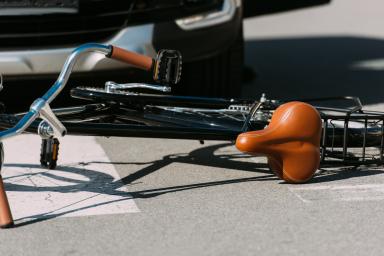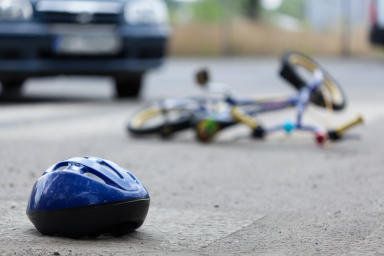Texas Bicycle Laws

Texas generally has a favorable climate for outdoor activities, including bicycling. The state experiences long periods of mild and warm weather, which makes cycling an attractive option for recreation, exercise, and commuting.
Just like any other state, Texas places importance on bicycle laws and regulations to ensure the safety of cyclists, motorists, and pedestrians. According to the Texas Department of Transportation’s annual crash statistics, the state had 2,265 bicycle accidents in 2021, which caused over 90 fatalities and more than 2,000 injuries.
These figures emphasize the significance of addressing bicycle safety and implementing measures to reduce the possibility of accidents. Promoting awareness of bicycle laws and encouraging responsible behavior by all road users are crucial steps toward mitigating the risks of riding a bike. Below are bicycle laws to remember when traversing the Lone Star State.
Road Laws for Bicycle Operators in Texas
The Texas Department of Transportation defines “bicycle” as a device that can be ridden by a person and is capable of being ridden solely using human power. Bicycle riders generally have the same rights and responsibilities as drivers of motor vehicles when sharing the road. Cyclists have the right to occupy and use public roads, and at the same time, they are expected to comply with the same traffic laws and regulations as motor vehicle drivers. Some of these regulations include following traffic signals, stopping at stop signs, yielding the right-of-way when necessary, and signaling turns or lane changes.
Here are a few general road laws to bear in mind when riding a bicycle:
Bicycles should only be ridden on streets, roadways, bike paths, designated routes, and areas explicitly designated for bicycle riding. Cyclists should primarily utilize these designated spaces.
Bicyclists must ride as close to the right-hand side of the road as possible. This practice allows for the smooth flow of traffic and safeguards both cyclists and motorists.
Cyclists should only ride on or sit astride a regular, permanent seat that is attached to the bicycle. Riding on a proper seat helps the rider maintain balance and control over the bike and prevents them from sitting in an unstable position, which may result in loss of control.
Cyclists should not use their bicycle to transport more people than the bike is designed or equipped to carry.
Texas Guidelines on Taking a Lane
Understanding the general guidelines on taking a lane helps cyclists position themselves appropriately, maximizing their visibility to motorists and decreasing the chances of any untoward accidents.
In certain situations, cyclists should consider taking a lane or occupying the full width of a traffic lane, to communicate their intentions to other motorists and keep themselves safe. These conditions include:
Traveling at the same speed as other traffic. If bicyclists are traveling at a similar speed as the surrounding vehicles, it is acceptable for them to take the travel lane. This ensures that they are visible to motorists and prevents unsafe passing attempts.
Passing another vehicle. When overtaking and passing another vehicle that is moving in the same direction, bicyclists may move into the travel lane to complete the maneuver safely.
Preparing for a left turn. When bicyclists intend to make a left turn at an upcoming intersection, they should take the travel lane to position themselves correctly.
Avoiding a hazard. If there is a hazard present on the road, such as debris, potholes, or an obstruction, bicyclists can take the travel lane to maneuver around the hazard safely.
Narrow lanes. In cases where the lane is too narrow for a bicycle and a motor vehicle to travel safely side by side, bicyclists can occupy the travel lane.
Texas Bicycle Laws on Hand Signals
Hand signals are important for bicycle safety as they help cyclists communicate their intentions to motorists and pedestrians. Here are the commonly recognized hand signals and their corresponding meanings:
Stop - To indicate a stop, extend the left hand and arm downward, with the palm facing to the rear. This signal clearly communicates the intention to slow down or come to a complete stop, giving motorists and others on the road ample time to react.
Left Turn - For cyclists planning to make a left turn, they must extend their left hand and arm horizontally to the left side of their body, forming a straight line with their shoulder.
Right Turn - There are two acceptable methods to signal a right turn. The first option is to extend the left hand and arm upward, forming a 90-degree angle at the elbow, with the forearm pointing vertically. Alternatively, cyclists can extend their right hand and arm horizontally to the right side of their body, also forming a straight line with their shoulder.
Bicycle Safety Equipment Laws in Texas
Riding a mechanically unsound bicycle can increase the risk of accidents and jeopardize one’s well-being, which is why prioritizing a bike's maintenance and proper functioning is important. The initial and crucial step is for bike owners to be aware of their bicycle's mechanical condition. Regular inspections and maintenance checks are necessary to identify and address potential issues.
Helmets
Helmets play a critical role in safeguarding bicycle riders against head injuries, which account for a significant portion of bicycle rider fatalities. In fact, approximately 60% of these fatalities are attributed to head injuries. Wearing an approved bicycle helmet is the most effective measure bikers can take to protect themselves while cycling.
When purchasing a helmet, it is essential to ensure a proper fit. A well-fitted helmet should cover the entire top of the head and sit level, with the strap securely fastened under the chin. Helmets with adjustable straps and padding can be customized to achieve an optimal fit for comfort and safety.
Brakes
Cyclists should ensure their bicycle has a functional braking system that enables the braked wheel to skid on dry, level, and clean pavement. When the rider hits the brakes, the friction between the brake pads and the wheel rim or disc creates resistance, gradually slowing down the bicycle. A well-functioning brake system ensures that this resistance is sufficient to bring the wheel to a halt.
Texas Laws on Nighttime Cycling
Operating a bicycle at nighttime in Texas is subject to specific requirements for securing visibility and safety. It is prohibited for individuals to ride a bicycle during nighttime unless the bike is equipped with the following lighting and reflector devices:
Headlamp - The bicycle must have a headlamp positioned on the front that emits a white light. This headlamp should be visible from a distance of at least 500 feet ahead of the bicycle. This bright light enhances the cyclist's visibility to others on the road, enabling them to anticipate the bicycle's presence.
Red Reflector or Red Lamp - A red reflector or red lamp is essential for enhancing the bicycle's visibility from the rear. The bike must be equipped with either a red reflector that is visible from at least 300 feet or a red lamp visible from 500 feet behind the bike. This rear visibility device enables motorists approaching from behind to clearly identify the presence of the bicycle and maintain a safe distance.
Keep in mind that prioritizing visibility through the use of appropriate lighting and reflectors not only promotes personal safety but also protects other road users.
Laws on Racing in Texas
Competitive Racing
A competitive bicycle race on a public road can only take place if it is approved by the relevant local law enforcement agencies. The sponsoring organization must seek permission and comply with the regulations set forth by these agencies to ensure the safety of all participants and the public.
Local law enforcement agencies and the sponsoring organization can collaborate to establish safety regulations governing the movement of bicycles. These regulations may cover various aspects, including the allowance for bicycle operators to ride abreast, meaning side by side.
Drag Racing
Drag racing on Texas streets is not allowed. Depending on previous convictions, an offender may be charged with Class A or B misdemeanor and face a year of jail time and fines not exceeding $4,000. Meanwhile, chronic offenders can face penalties as harsh as a third-degree felony, with a punishment of 10 years in prison and $10,000 in total fines.
Texas Guidelines on Bicycle Crashes
If you figure in a bicycle crash in Texas, it is important to take immediate actions to secure your safety, seek medical attention if necessary, and gather relevant information for any potential legal or insurance purposes. Here are a few guidelines that individuals can follow:
Immediately call 9-1-1 and request police assistance. Even if the victim is not injured, do not hesitate to ask for an ambulance. Prompt medical attention is crucial.
Move the bicycle out of the roadway to a safer place to prevent further accidents or injuries.
Approach the driver of the motor vehicle and politely ask for his address, phone number, vehicle identification number, vehicle license plate number, insurance information, and driver's license information. These details will be necessary for insurance claims and further legal actions.
Collect the names and phone numbers of any witnesses at the scene. The more witnesses, the better. If they have business cards, ask for one so you can obtain their accurate contact details.
It is important to stay at the scene until the police arrive. If the motor vehicle driver leaves before the police arrive, he may be considered guilty of hit and run, which is a serious crime.
Consider seeking legal advice from a lawyer expert in bicycle accident-related cases, especially when there were severe injuries or another party was at fault for the crash.
Is Texas a No-Fault State for Bike Accidents?
Texas does not operate under a no-fault system for bike accidents. It follows a rule called modified comparative fault, specifically known as the 51% rule. This system determines how much compensation an injured person can receive based on their level of fault in causing the accident.
According to the 51% rule, if an injured person is found to be more than 50% at fault for the accident, he will not be able to recover any damages. However, if the injured person is 50% or less at fault, he can still seek compensation for his injuries, but the amount he will receive will be reduced based on the degree of fault assigned to him.
Determining liability in an accident can be a complex process, often requiring the evaluation of evidence and legal expertise. Consulting with a lawyer who specializes in personal injury cases can provide guidance and help navigate the legal aspects of seeking compensation after a bike accident in Texas.
How Much Can Someone Sue for a Bicycle Accident in Texas
The recoverable amount for a bicycle accident lawsuit in Texas varies depending on several factors, including the extent of the injuries, medical expenses, property damage, lost wages, pain and suffering, and other related losses.
In a personal injury lawsuit resulting from a bicycle accident, the injured party may seek compensation for various types of damages, such as:
Economic Damages - These include medical expenses, rehabilitation costs, property damage (such as damage to the bicycle), lost wages, and future financial losses related to the accident.
Non-Economic Damages - These are subjective losses that cannot be easily quantified. Examples of non-economic damages include pain and suffering, emotional distress, scarring, disfigurement, loss of enjoyment of life, and loss of consortium.
Punitive Damages - In rare cases where the defendant's conduct is found to be particularly reckless or intentional, punitive damages may be awarded to punish the defendant and deter similar behavior in the future. In Texas, punitive damages are capped at either $200,000 or double the total economic damages plus the non-economic damages up to $750,000, whichever amount is greater. However, in cases where the defendant's negligent act is a felony, the punitive damages caps do not apply.
What Is Texas’ Statute of Limitations for Bicycle Accidents?
In Texas, the statute of limitations for filing a personal injury lawsuit, including bicycle accident cases, is generally two years from the date of the accident. This means individuals injured in a bicycle crash must file their lawsuit within two years from the date of the incident, or they may lose their right to seek compensation through the court system.
However, there are certain exceptions to the standard two-year statute of limitations, which include:
If the injured person is a minor (under the age of 18) at the time of the accident, the two-year statute of limitations does not begin until he reaches 18. This means he has until his 20th birthday to file a lawsuit.
In cases where the injury resulting from the bicycle accident was not immediately apparent, the statute of limitations may start from when the injury was discovered or should have been reasonably discovered.
Legal Resources for Texas Bicycle Accident Victims
State Bar of Texas
The State Bar of Texas is the official organization of lawyers in the state. Its website provides a directory of attorneys and useful resources for Texans seeking legal assistance. It can search for personal injury attorneys with expertise in bicycle accident matters nearby. The website also provides legal publications that can help individuals get the latest information related to their cases.
Bike Texas
Bike Texas’ primary mission is to promote bicycle safety and become the voice for bicycle operators and riders. It provides resources, advocacy, and support for cyclists across the state. The Bike Texas website offers valuable information on laws, safety tips, and resources for bicycle accident victims.
Care for Accident Victims
Care for Accident Victims is a registered nonprofit organization dedicated to providing support and resources to individuals and their families who have been involved in accidents in Texas. Its website also informs visitors about traffic accidents throughout the state to promote awareness and increase safety measures on the road.
TexasLawHelp.org
TexasLawHelp.org offers free legal assistance and resources to low-income individuals, including those involved in bicycle accidents in the state. It discusses topics on legal rights, enables access to legal representation, and provides guidance on personal injury claims. This website is part of a broader national initiative in the legal aid sector, utilizing technology to improve and strengthen the accessibility of legal services. With over four million visitors in the past year alone, TexasLawHelp.org has become a valuable resource for Texans seeking legal guidance.
Expertise.com StaffAuthor
Step into the world of Expertise.com, your go-to hub for credible insights. We don't take accuracy lightly around here. Our squad of expert reviewers, each a maestro in their field, has given the green light to every single article you'll find. From rigorous fact-checking to meticulous evaluations of service providers, we've got it all covered. So feel free to dive in and explore. The information you'll uncover has been stamped with the seal of approval by our top-notch experts.




